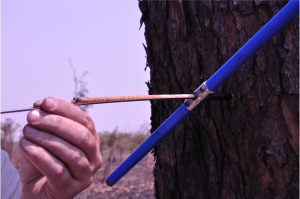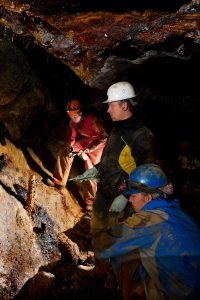 The paper presents a geochemical analysis of a remarkable assemblage from the early La Tène period (4th century BCE): the Duchcov hoard found in the late 19th century in north-western Bohemia. More than a thousand pieces of bronze jewellery in a bronze cauldron were deposited in a natural spring. This possibly ritual offering of unknown purpose might have involved a large community whose origin and structure could be discussed using archaeometric data from the hoard. This assemblage offers a unique opportunity to study Iron Age bronze metalworking. The results show that this seemingly homogeneous assemblage contains several chemically distinctive groups that are compatible with the spread of the so-called Duchcov-Münsingen horizon in the 4th century BCE.
The paper presents a geochemical analysis of a remarkable assemblage from the early La Tène period (4th century BCE): the Duchcov hoard found in the late 19th century in north-western Bohemia. More than a thousand pieces of bronze jewellery in a bronze cauldron were deposited in a natural spring. This possibly ritual offering of unknown purpose might have involved a large community whose origin and structure could be discussed using archaeometric data from the hoard. This assemblage offers a unique opportunity to study Iron Age bronze metalworking. The results show that this seemingly homogeneous assemblage contains several chemically distinctive groups that are compatible with the spread of the so-called Duchcov-Münsingen horizon in the 4th century BCE.
Danielisová A., Pajdla P., Bursák D., Strnad L., Trubač J., Kmošek J. (2021): Claiming the land or protecting the goods? The Duchcov hoard in Bohemia as a proxy for ‘Celtic migrations’ in Europe in the 4th century BCE. Journal of Archaeological Science 127, 105314. (DOI)






 We used pine tree rings and soil geochemistry to expose the activity of a Pb-Zn smelter in Kabwe, Zambia. We found that local soils are extremely contaminated (up to 16000 mg/kg Pb; 14000 mg/kg Zn; 600 mg/kg Cu in the topsoil). Also, metal bearing particles share their Pb isotopic signature with smelting by-products, and more concerning, metals in tree biomass. We concluded that these metals enter the tree though the bark and leaves, not the roots, implying airborne contamination. Using Pb and C isotopes we mapped the dendrochronology of the tree and verified its susceptibility to changes in smelter production throughout the late 20th century.
We used pine tree rings and soil geochemistry to expose the activity of a Pb-Zn smelter in Kabwe, Zambia. We found that local soils are extremely contaminated (up to 16000 mg/kg Pb; 14000 mg/kg Zn; 600 mg/kg Cu in the topsoil). Also, metal bearing particles share their Pb isotopic signature with smelting by-products, and more concerning, metals in tree biomass. We concluded that these metals enter the tree though the bark and leaves, not the roots, implying airborne contamination. Using Pb and C isotopes we mapped the dendrochronology of the tree and verified its susceptibility to changes in smelter production throughout the late 20th century. Arsenic-rich stalactites (0.13-294 g/kg As) collected from abandoned adits of the Plavno and Mikulov mines (NW Czech Republic) consist of HFA, HFO, kaňkite, schwertmannite, and hydrous manganese oxide mineral phases. These phases were often combined in one stalactite, forming domains, layers and coprecipitates. The microbial communities indicated autotrophic oxidation of Fe(II), As(III), and reduced sulphur compounds as the most notable biological processes influencing the mineralogy in studied stalactites.
Arsenic-rich stalactites (0.13-294 g/kg As) collected from abandoned adits of the Plavno and Mikulov mines (NW Czech Republic) consist of HFA, HFO, kaňkite, schwertmannite, and hydrous manganese oxide mineral phases. These phases were often combined in one stalactite, forming domains, layers and coprecipitates. The microbial communities indicated autotrophic oxidation of Fe(II), As(III), and reduced sulphur compounds as the most notable biological processes influencing the mineralogy in studied stalactites. We combined selective chemical extractions and S isotopes to examine the mobility of As and trace metals (Co, Cu, Ni) in two Czech wetland soils enriched in authigenic Fe-As sulfide minerals through the drying process. We found that As and trace metals released via oxidation of the sulfide phases (particularly Fe sulfides) were almost entirely sequestered by Fe(III) (oxyhydr)oxides, but concomitant acidification resulted in the pH-dependent release of the As(III) and trace metals. Although our results documented the relatively low As mobilization potential under relatively short droughts (several weeks), the preservation of the anoxic conditions must be regarded as a fundamental management strategy of these and other sulfidic wetlands enriched in As.
We combined selective chemical extractions and S isotopes to examine the mobility of As and trace metals (Co, Cu, Ni) in two Czech wetland soils enriched in authigenic Fe-As sulfide minerals through the drying process. We found that As and trace metals released via oxidation of the sulfide phases (particularly Fe sulfides) were almost entirely sequestered by Fe(III) (oxyhydr)oxides, but concomitant acidification resulted in the pH-dependent release of the As(III) and trace metals. Although our results documented the relatively low As mobilization potential under relatively short droughts (several weeks), the preservation of the anoxic conditions must be regarded as a fundamental management strategy of these and other sulfidic wetlands enriched in As. Vanadium is a key critical metal with many applications in the steel and chemical industry. Slags issued from the metallurgical processing of Pb-Zn vanadate ores at Berg Aukas (Namibia) and Kabwe (Zambia) exhibit interestingly high concentrations of V (up to 6140 ppm) and can be considered potential sources of this metal. Two papers published recently by our research group focused on geochemistry and mineralogy of these slags combined with laboratory simulation of the hydrometallurgical extractive processes in view of potential V recovery. The results indicate that, despite high V bulk concentrations and extractabilities, its recovery seems to be non-economical, mainly due to low prices of V (and other associated valuable elements such as Zn) on the global market.
Vanadium is a key critical metal with many applications in the steel and chemical industry. Slags issued from the metallurgical processing of Pb-Zn vanadate ores at Berg Aukas (Namibia) and Kabwe (Zambia) exhibit interestingly high concentrations of V (up to 6140 ppm) and can be considered potential sources of this metal. Two papers published recently by our research group focused on geochemistry and mineralogy of these slags combined with laboratory simulation of the hydrometallurgical extractive processes in view of potential V recovery. The results indicate that, despite high V bulk concentrations and extractabilities, its recovery seems to be non-economical, mainly due to low prices of V (and other associated valuable elements such as Zn) on the global market.
 Mercury distribution in topsoils and vegetation samples and temperature-dependent Hg mobilization simulating wildfires have been investigated near a Cu smelter in semi-arid Namibia. The thermo-desorption experiments performed on the representative Hg-rich topsoils indicated that >91% of the Hg was released at ~340°C, which corresponds to the predominant grassland-fire conditions. Despite the installation of a sulfuric acid plant in the smelter in 2015 and a calculated drop in the estimated Hg emissions (from 1301 ± 457 kg/y for the period 2004-2015 to 67 ± 5 kg/y after 2015), the Hg legacy pool in the smelter surroundings will contribute to wildfire-driven Hg emissions until its complete burn-out. Using the Hg spatial distribution data in the area (184 km2), the estimates indicate that up to 303 kg and 1.3 kg can be remobilized from the topsoils and vegetation, respectively.
Mercury distribution in topsoils and vegetation samples and temperature-dependent Hg mobilization simulating wildfires have been investigated near a Cu smelter in semi-arid Namibia. The thermo-desorption experiments performed on the representative Hg-rich topsoils indicated that >91% of the Hg was released at ~340°C, which corresponds to the predominant grassland-fire conditions. Despite the installation of a sulfuric acid plant in the smelter in 2015 and a calculated drop in the estimated Hg emissions (from 1301 ± 457 kg/y for the period 2004-2015 to 67 ± 5 kg/y after 2015), the Hg legacy pool in the smelter surroundings will contribute to wildfire-driven Hg emissions until its complete burn-out. Using the Hg spatial distribution data in the area (184 km2), the estimates indicate that up to 303 kg and 1.3 kg can be remobilized from the topsoils and vegetation, respectively. This study investigated As-enriched wetland at the Smolotely-Líšnice Au district (Centra Bohemia) using the combination of geochemical (soil and pore water analyses, S isotopes), mineralogical (microprobe, Raman spectrometry) and biological (DNA extraction) method. In this paper, Magda and her co-authors identified a complex assemblage of As and Fe sulfides (realgar, bonazziite, pyrite, greigite) on the fragments of natural organic matter, which play an active role (very fast microbial sulfate reduction vs. slow transfer of solutes) in arsenic immobilization in polluted wetland systems.
This study investigated As-enriched wetland at the Smolotely-Líšnice Au district (Centra Bohemia) using the combination of geochemical (soil and pore water analyses, S isotopes), mineralogical (microprobe, Raman spectrometry) and biological (DNA extraction) method. In this paper, Magda and her co-authors identified a complex assemblage of As and Fe sulfides (realgar, bonazziite, pyrite, greigite) on the fragments of natural organic matter, which play an active role (very fast microbial sulfate reduction vs. slow transfer of solutes) in arsenic immobilization in polluted wetland systems. We combined elemental and isotopic studies, leaching techniques and speciation modeling to describe Cu and Pb behavior in contaminated soil profiles of Kombat, Namibia. Tailings, soils and bedrock samples were analyzed. We described pollutants’ behavior in detail for different type of soils and concluded that migration is highly dependent on soil characteristics and element speciation shown by variations, or lack thereof, in concentrations, δ65Cu and 206Pb/207Pb values with depth.
We combined elemental and isotopic studies, leaching techniques and speciation modeling to describe Cu and Pb behavior in contaminated soil profiles of Kombat, Namibia. Tailings, soils and bedrock samples were analyzed. We described pollutants’ behavior in detail for different type of soils and concluded that migration is highly dependent on soil characteristics and element speciation shown by variations, or lack thereof, in concentrations, δ65Cu and 206Pb/207Pb values with depth. We used a multi-method approach for characterization of dust from mines and smelters in the northern Namibia. In vitro bioaccessibility testing in simulated gastric fluid (SGF) indicated that As, Pb (and also Cd to a lesser extent) exceeded tolerable daily intake limits for these contaminants in the case of slags and smelter dusts, but the exposure risk for local population is only important at the unfenced disposal sites.
We used a multi-method approach for characterization of dust from mines and smelters in the northern Namibia. In vitro bioaccessibility testing in simulated gastric fluid (SGF) indicated that As, Pb (and also Cd to a lesser extent) exceeded tolerable daily intake limits for these contaminants in the case of slags and smelter dusts, but the exposure risk for local population is only important at the unfenced disposal sites.